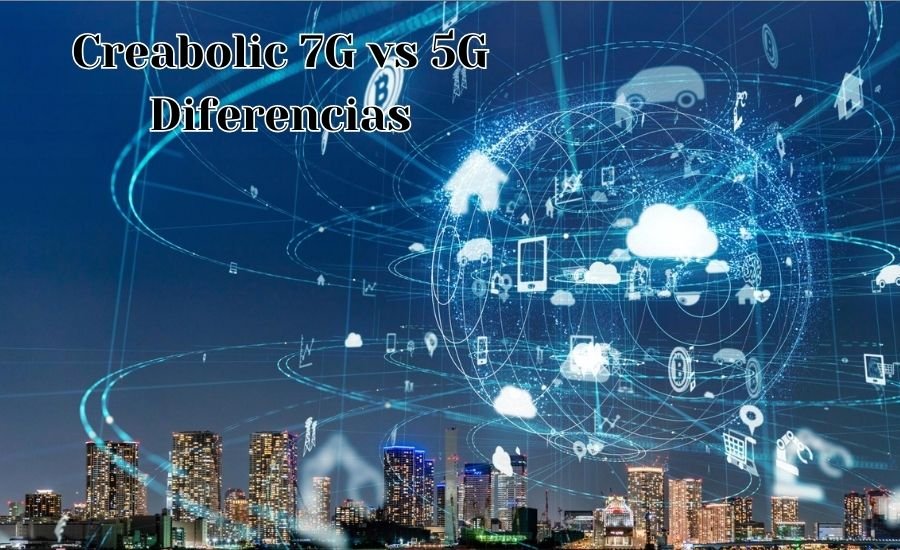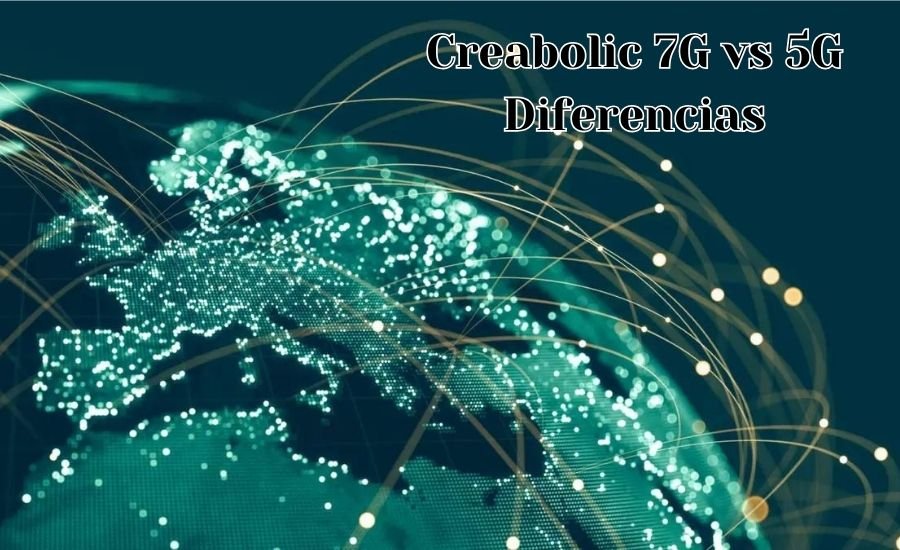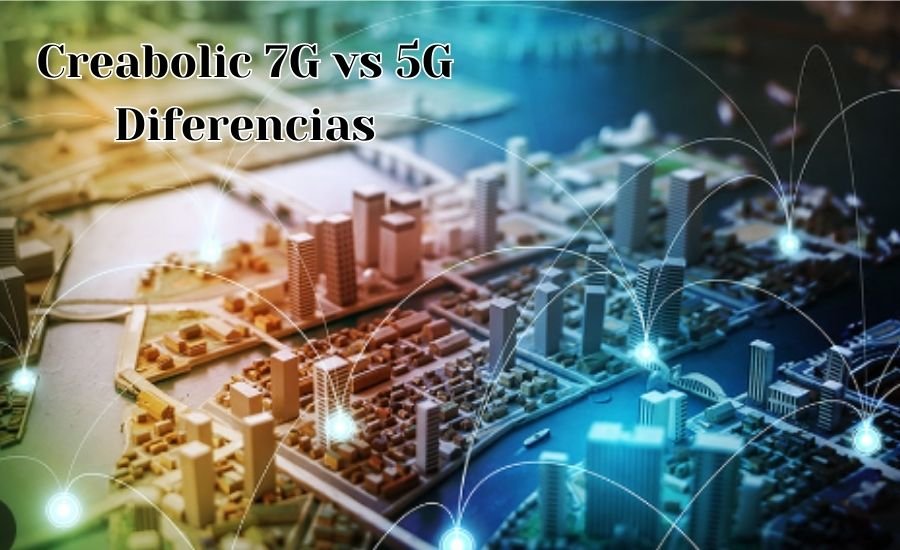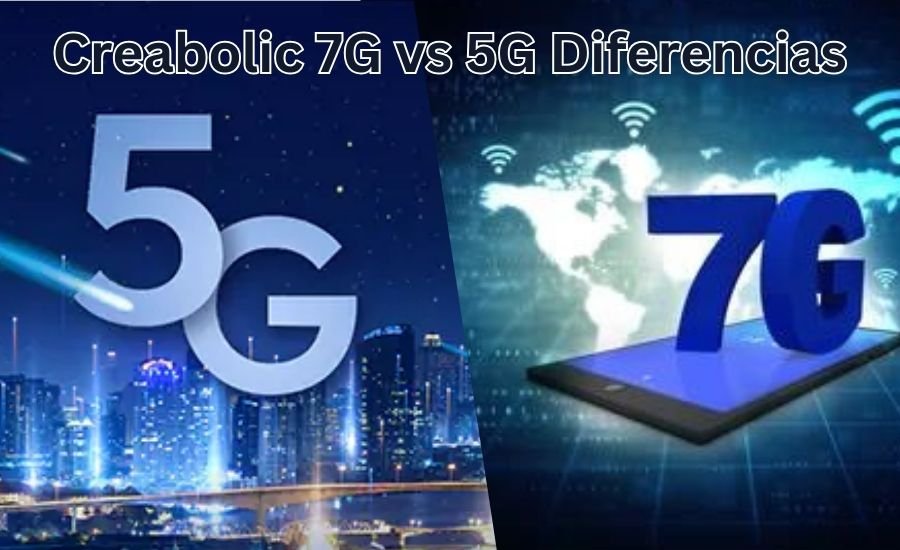Are you wondering about the Creabolic 7g vs 5g Diferencias? The battle between these two network generations is heating up as technology continues to evolve. Creabolic 7G promises faster speeds, lower latency, and more reliable connections compared to the current 5G network.
In this post, we’ll explore the major differences between Creabolic 7G vs 5G diferencias and why 7G might be the game-changer for mobile connectivity. Whether you’re curious about internet speeds, global coverage, or future tech possibilities, we’ve got you covered. Let’s dive into what sets these two generations apart.
What are creabolic 7g vs 5g diferencias?
Creabolic 7G is the next step in mobile technology after 5G. It is designed to bring faster internet speeds, better coverage, and almost no delay in communication. With Creabolic 7G, people will be able to download movies, play games, and use apps faster than ever before. This new technology is being developed to meet the growing demand for high-speed internet and reliable connectivity everywhere.
The 7G network is not only about speed. It also promises to improve connections between devices and allow more gadgets to connect to the internet. This will help with things like smart homes, where devices need to talk to each other to work properly. The development of Creabolic 7G vs 5G diferencias shows how much technology is changing.
As the world moves towards more advanced technology, 7G could be the solution to many of the challenges we face with 5G. For example, Creabolic 7G will likely use satellites to provide better coverage, meaning even remote areas could get faster internet. The difference between Creabolic 7G vs 5G is clear when we look at these improvements.
Creabolic 7G vs 5G: Key Differences
When comparing Creabolic 7G vs 5G diferencias, the most obvious differences:
Creabolic 7G
- Speed: Offers significantly higher data rates than 5G, enabling faster downloads and uploads.
- Global Coverage: Utilizes satellite technology for improved connectivity, reaching remote areas effectively.
- Latency: Features extremely low latency, enhancing real-time communication and interactions.
- Technology: Integrates advanced AI for network management, making it more efficient and responsive.
- User Capacity: Supports a larger number of connected devices simultaneously, ideal for smart cities and IoT applications.
5G
- Speed: Provides faster internet than previous generations, but slower than anticipated 7G speeds.
- Coverage: Relies on ground-based towers, which can limit access in rural and remote locations.
- Latency: Offers reduced latency compared to 4G, but not as low as 7G.
- Technology: Primarily focuses on enhancing mobile internet and connectivity for various devices.
- User Capacity: Supports multiple connections but can face congestion in high-traffic areas.
How Does Creabolic 7G Work?

Creabolic 7G uses a combination of advanced technology and satellite systems to provide high-speed internet and reliable connections. Unlike 5G, which relies mainly on ground towers, 7G will use space-based satellites to offer a wider and more stable connection. This will make it easier for people to stay connected, no matter where they are in the world.
The satellites used in 7G will allow for stronger signals, even in places where 5G has trouble, like mountains or isolated areas. This is one of the key creabolic 7g vs 5g diferencias, as 7G will be able to provide fast internet to nearly every corner of the globe. It’s an exciting step forward for mobile technology.
Another big change with 7G is the way it connects devices. With 7G, more gadgets like smart refrigerators, cars, and even medical equipment will be able to connect to the internet without slowing down the network. The network will be smarter and able to handle more data at once, which will improve our daily lives.
Creabolic 7G vs 5G: Speed Comparison
Speed is one of the main differences when discussing creabolic 7g vs 5g diferencias. While 5G is already much faster than 4G, offering speeds of up to 1 Gbps, 7G is expected to provide speeds that are even higher—up to 10 Gbps or more. This means that downloading large files, streaming HD videos, and playing online games will happen almost instantly with 7G.
In comparison, 5G is fast but can slow down in busy places like stadiums or concerts where many people are connected at the same time. Creabolic 7G aims to solve this problem by offering more bandwidth and faster speeds, even in crowded areas. This makes a big difference for users who rely on fast internet for work or entertainment.
Another important factor is the overall user experience. With 7G, users can expect smoother and more reliable connections, especially in areas where 5G might struggle. The creabolic 7g vs 5g diferencias are clear when looking at how these two technologies handle large amounts of data.
Latency: Creabolic 7G vs 5G
Latency is the time it takes for data to travel from one device to another. In creabolic 7g vs 5g diferencias, 7G is expected to have almost zero latency, making it perfect for real-time activities like video calls, gaming, and remote surgeries. 5G already has low latency, but 7G will be even faster, providing smoother experiences.
For things like virtual reality (VR) and augmented reality (AR), low latency is critical. 5G can support these technologies, but with some delay. Creabolic 7G, however, will allow for real-time interaction without any noticeable lag. This will change how we communicate and interact with the digital world.
As technology advances, having lower latency becomes more important, especially in industries like healthcare and transportation. Creabolic 7G’s ability to provide instant communication could be a game-changer for many industries, showing the real creabolic 7g vs 5g diferencias in performance.
Creabolic 7G vs 5G: Network Coverage Differences
One of the most notable creabolic 7g vs 5g diferencias is in network coverage. While 5G has improved coverage compared to 4G, it still relies on ground-based towers to provide its signal. This means that rural or remote areas may not receive the same strong connection as cities do. Creabolic 7G, on the other hand, will take advantage of satellite technology to provide a more global and consistent network.
Creabolic 7G will make it easier for people in hard-to-reach areas, like mountains or forests, to access the internet without the worry of losing a signal. Satellite technology will cover these places, giving users a stronger connection wherever they are. This is a big improvement over 5G, which sometimes struggles in areas without enough cell towers.
In addition, 7G is expected to work well even in crowded urban spaces. Where 5G might slow down when too many people are using the same network, 7G will be able to handle more users at once, ensuring that everyone gets a fast and reliable connection. This is one of the main benefits when comparing creabolic 7g vs 5g diferencias in coverage.
Power Consumption: Creabolic 7G vs 5G

When it comes to power consumption, there are important creabolic 7g vs 5g diferencias to consider. 5G networks consume more energy than 4G because they use more towers and higher frequencies to deliver faster speeds. This makes 5G networks more power-hungry, which can drain your device’s battery faster than 4G.
Creabolic 7G, however, is expected to be more energy-efficient. By using satellites instead of ground-based towers, 7G will be able to deliver high-speed internet while consuming less power. This means that devices using 7G will likely have a longer battery life compared to those using 5G. It’s one of the significant advantages that could make 7G more appealing to users who rely on their devices for long periods.
For industries that use large amounts of data or depend on continuous connectivity, the energy efficiency of 7G could also mean lower costs and a reduced environmental impact. These creabolic 7g vs 5g diferencias in power usage will likely play a big role in the future of mobile technology.
Device Compatibility: Creabolic 7G vs 5G
Another key area where creabolic 7g vs 5g diferencias stand out is device compatibility. Currently, 5G is compatible with many of the latest smartphones, tablets, and IoT (Internet of Things) devices. Most modern gadgets are built to connect to 5G networks, allowing for faster browsing, streaming, and downloading. However, 7G will introduce new possibilities for even more advanced devices.
Creabolic 7G will support a wider range of smart devices, including more complex IoT systems. This means that things like smart homes, connected cars, and even medical equipment could benefit from the higher speeds and more stable connections that 7G offers. In the future, we may see many more devices designed specifically for 7G networks.
In addition to smartphones and tablets, industries like healthcare and transportation are expected to benefit from the expanded device compatibility of 7G. Whether it’s smart hospitals or self-driving cars, 7G will enable more reliable and efficient connections for these advanced technologies, further showcasing the creabolic 7g vs 5g diferencias in device support.
Security Enhancements in Creabolic 7G vs 5G
Security is a major concern in today’s digital world, and there are several creabolic 7g vs 5g diferencias when it comes to protecting user data. While 5G has made improvements in security compared to 4G, it still has some vulnerabilities that hackers can exploit. Creabolic 7G aims to address these issues with more advanced security protocols.
Creabolic 7G will use stronger encryption and more secure network management systems to protect users from cyber threats. This means that sensitive data, such as personal information or financial transactions, will be safer on a 7G network compared to a 5G one. As technology advances, so do cyber-attacks, making security enhancements a key factor in the creabolic 7g vs 5g diferencias.
For industries like banking, healthcare, and government services, these security upgrades could be crucial. 7G’s advanced protections will help ensure that important data stays safe, giving users more confidence when using the internet for sensitive activities. This security focus is another reason why 7G may become the preferred network of the future.
Latency Differences: Creabolic 7G vs 5G
One of the major creabolic 7g vs 5g diferencias is in latency. Latency refers to the time it takes for data to travel from one point to another. With 5G, the latency is already very low compared to previous networks like 4G. This is why 5G is praised for applications that need quick response times, like gaming, live streaming, and video calls.
However, Creabolic 7G is expected to reduce latency even further. This means that tasks like virtual reality (VR) or augmented reality (AR) will be smoother and more seamless, with almost no lag. The lower latency of 7G will also help in fields such as healthcare, where real-time data is critical, for example, during remote surgeries or monitoring patients’ health in real-time.
In industries like transportation, the low latency of Creabolic 7G will support self-driving cars and drones, allowing them to respond instantly to their surroundings. Whether for personal or professional use, the difference in latency will make Creabolic 7G a game-changer compared to 5G, highlighting important creabolic 7g vs 5g diferencias in performance.
Pricing and Affordability: Creabolic 7G vs 5G

When considering creabolic 7g vs 5g diferencias, one important factor is cost. Currently, 5G networks are becoming more affordable as the technology becomes widespread. Many mobile carriers offer 5G services at reasonable prices, and the cost of 5G-compatible devices is also coming down as more manufacturers adopt the technology.
Creabolic 7G, being a newer technology, may initially be more expensive. The costs of building and maintaining satellite infrastructure are higher than for ground-based towers. This could mean that early users of 7G might need to pay more for faster speeds and global coverage. However, as the technology develops and becomes more common, prices are expected to drop, much like what happened with 5G.
In the long run, the broader capabilities and improved efficiency of 7G might justify the initial higher costs. For businesses and industries that rely on high-speed and reliable connections, the benefits of 7G could outweigh the price difference. So, while 5G is more affordable today, the creabolic 7g vs 5g diferencias in pricing may level out in the future as 7G becomes more accessible.
Impact on Daily Life: Creabolic 7G vs 5G
The creabolic 7g vs 5g diferencias will also significantly impact everyday life. Right now, 5G has already changed how we use the internet, offering faster speeds for downloading, streaming, and browsing. People are enjoying smoother experiences on social media, online gaming, and video calls thanks to 5G’s capabilities.
With Creabolic 7G, these experiences will get even better. The faster speeds, lower latency, and global coverage of 7G will make it easier for people to stay connected no matter where they are. This could be especially helpful for students and professionals who work or study remotely. 7G’s satellite-based network could mean no more worrying about weak signals or dropped connections.
Moreover, 7G will enhance smart home devices, making everyday tasks like controlling the thermostat, lights, or security systems more reliable. As technology continues to advance, the creabolic 7g vs 5g diferencias will shape how we interact with the digital world, making our lives even more connected and convenient.
Creabolic 7G vs 5G in Smart Cities
The creabolic 7g vs 5g diferencias are especially important for smart cities. Smart cities rely on fast, stable internet connections to manage things like traffic, energy usage, and public safety. With 5G, many cities have already started adopting smart technology to improve the quality of life for their citizens.
Creabolic 7G, with its global coverage and higher speeds, will take smart city development to the next level. For example, real-time data from traffic cameras and sensors could be processed even faster, helping to reduce congestion and accidents. 7G could also make energy grids smarter, allowing cities to manage electricity more efficiently and reduce waste.
In addition, Creabolic 7G could help improve public safety by supporting better communication systems for first responders and emergency services. With more reliable connections, they can respond faster and more effectively in times of crisis. As cities become more connected, the creabolic 7g vs 5g diferencias will play a big role in shaping the future of urban life.
Global Accessibility: Creabolic 7G vs 5G
When it comes to global accessibility, the creabolic 7g vs 5g diferencias are substantial. 5G technology mainly relies on terrestrial towers to provide coverage, which works well in urban areas but can struggle in remote regions or places with challenging terrain. This limitation means that some parts of the world, especially rural areas, still lack reliable 5G access.
Creabolic 7G aims to solve this issue by relying on satellites instead of ground-based infrastructure. This means that no matter where you are, whether deep in a forest or high in the mountains, you can expect stable and fast internet access with 7G. Global satellite coverage will make the internet truly accessible to everyone, bridging the digital divide and ensuring even the most isolated areas can connect to the rest of the world.
This broader coverage will benefit not only individual users but also industries like agriculture, mining, and shipping, which often operate in remote locations. By providing internet access to these areas, Creabolic 7G will help boost productivity and enable new opportunities in places that 5G cannot reach. The creabolic 7g vs 5g diferencias in coverage will open up new possibilities for global communication and development.
Get More Info: 2607:fb91:15af:7350::62
Sustainability and Environmental Impact: Creabolic 7G vs 5G

Another key point when comparing creabolic 7g vs 5g diferencias is their environmental impact. 5G technology, while faster and more efficient than 4G, still relies heavily on physical infrastructure like cell towers, which require energy to operate. Additionally, the manufacturing of 5G devices and equipment contributes to electronic waste.
Creabolic 7G, on the other hand, may have a different environmental footprint. Since 7G uses satellite technology, it eliminates the need for extensive ground-based infrastructure. However, the production and launch of satellites come with their own environmental concerns, such as the use of fuel and materials to send them into orbit.
That being said, Creabolic 7G could still be a more sustainable option in the long term. The improved efficiency and reduced need for physical towers may result in lower overall energy consumption. Furthermore, the global reach of 7G could support sustainable initiatives by enabling better data collection for climate monitoring, environmental research, and more efficient energy use in smart cities. The creabolic 7g vs 5g diferencias in sustainability could make 7G the greener choice for the future.
Creabolic 7G vs 5G: Which Is Better for Businesses?
For businesses, understanding the creabolic 7g vs 5g diferencias is essential to choosing the right technology. Many companies already benefit from 5G’s fast speeds and reliable connectivity, particularly in sectors like retail, logistics, and entertainment. 5G allows businesses to use advanced technologies such as artificial intelligence (AI), virtual reality (VR), and the Internet of Things (IoT) to enhance operations.
Creabolic 7G, however, is poised to offer even greater advantages for businesses, especially those operating on a global scale. With 7G’s improved coverage and faster speeds, international companies can connect more easily with partners and customers across different regions. This is especially useful for industries like shipping, aviation, and remote work, where staying connected in all parts of the world is crucial.
Moreover, businesses that rely on real-time data, like those in healthcare or finance, will benefit from 7G’s lower latency, which ensures that transactions, diagnostics, and communications happen without delay. As technology advances, the creabolic 7g vs 5g diferencias will influence how businesses grow and innovate in the future, making Creabolic 7G a potentially better choice for companies looking to stay ahead of the curve.
Conclusion
In the end, when we look at creabolic 7g vs 5g diferencias, it’s clear that 7G will bring big improvements. It promises faster internet, better global coverage, and less delay in communication. While 5G has helped us enjoy faster speeds than before, 7G will take things to a whole new level, making sure that even people in faraway places can stay connected.
As we move into the future, creabolic 7g vs 5g diferencias show that 7G could change how we use technology every day. From businesses to regular people, everyone will benefit from 7G’s super-fast and reliable connections. Whether it’s watching videos, making calls, or running smart cities, 7G will make everything quicker and easier for everyone.
Read Next: 26100.1.240331-1435.ge_release_clientchina_oem_x64fre_zh-cn.iso
FAQs
Q: What is the main difference between Creabolic 7G and 5G?
A: The main difference is that Creabolic 7G offers faster speeds and better global coverage using satellites, while 5G relies on ground-based towers.
Q: How will Creabolic 7G improve internet access?
A: Creabolic 7G will provide internet access to remote and rural areas by using satellite technology, making it available almost anywhere in the world.
Q: Is Creabolic 7G faster than 5G?
A: Yes, Creabolic 7G is designed to be significantly faster than 5G, providing higher data rates and lower latency for quicker communication.
Q: What are the benefits of using satellites for internet connectivity?
A: Satellites can cover larger areas and reach places where traditional towers can’t, ensuring more people have access to the internet.
Q: Will businesses benefit from Creabolic 7G?
A: Yes, businesses will benefit from faster speeds and better connectivity, allowing for smoother operations and improved communication across different locations.
Q: Can I use Creabolic 7G for online gaming?
A: Absolutely! Creabolic 7G’s low latency and high speeds will make it great for online gaming, reducing lag and improving the overall experience.
Q: When is Creabolic 7G expected to be available?
A: Creabolic 7G is expected to roll out in the early 2030s, but specific dates may vary depending on technological developments and deployments.
